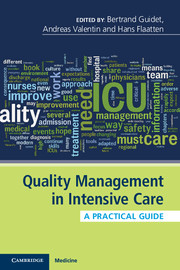Book contents
- Quality Management in Intensive CareA Practical Guide
- Quality Management in Intensive Care
- Copyright page
- Contents
- Contributors
- Introduction
- Section 1 Quality management of patient care
- Section 2 Quality management of the ICU
- Section 3 Quality management on the national (and international) level
- Epilogue
- Index
- References
Section 1 - Quality management of patient care
Published online by Cambridge University Press: 05 February 2016
- Quality Management in Intensive CareA Practical Guide
- Quality Management in Intensive Care
- Copyright page
- Contents
- Contributors
- Introduction
- Section 1 Quality management of patient care
- Section 2 Quality management of the ICU
- Section 3 Quality management on the national (and international) level
- Epilogue
- Index
- References
- Type
- Chapter
- Information
- Quality Management in Intensive CareA Practical Guide, pp. 1 - 94Publisher: Cambridge University PressPrint publication year: 2016

